Šljivovica, plum rakija from Serbia is a world famous alcoholic beverage. Mostly homemade, it exceeds any other spirit.
Serbian people have many uses of rakija. It has an important role in everyday and ritual life. There is no slava, wedding or funeral without rakija. Although the consequences of alcoholism are very well known, Serbian people has always considered rakija more useful than harmful. There is a saying "Rakija is medicine". Many elders drink it every morning on empty stomach because it opens the appetite. In traditional medicine it was used as the basic disinfectant.
History of rakija is blurry. Slavs came to Balkans in VII century and their affinity to Medovača, spirit made of honey, was documented in V century. We should certainly not ignore the fact that various fruit spirits were made and that they could have "evolved" into rakija. Speaking in the favor of the assumption that rakija was made in Serbia even before XV century is the fact that there is a paragraph about alcohol misuse in Dušan's Code (XIV century), one of the most significant Medieval law documents:
Although the type of alcoholic beverage is not specified exactly, it is most important to know that the process of distillation was know in that time and that knowledge was almost certainly applied for making fruit rakijas.
Rakija probably got it's name from arak ("Al-rak" - sweat) - a spirit distilled from palm sap, brought to the Balkans by Ottomans. We also know that there were stills in Serbia in that time since there was a "still tax" of 12 akçes. After the First and the Second Serbian Uprising, production of rakija rapidly started to grow.
Every family has it's own recipe for making rakija. This is how Mateja's uncle makes it:
Fermentation: Prunus Domestica is cleaned thoroughly and pitted. It is left in a 1000l barrel covered and it will look like this after approximately 21 days. There is a top layer that got molded which is called "cake" and is thrown away. The good part thet is left is called komina.
Distillation apparatus:
Copper still - a part where fermented komina is cooked. It has a thick bottom and a mixer that prevents burning of rakija.
The dome (kalpak) - goes on the top of still and it's function is to collect vapors created during cooking.
Condensator (tabarka) - attached to the still with a pipe, cools the vapors into liquid.
Fire in the still is traditionally made with wood, but in the recent times new techniques are emerging. This one is gas burner, it is a lot cheaper and effective - regulating the heat is much easier.
The most fun part - tasting :) The first rakija that comes from the condensator is thrown away. Due to presence of pectin in fruit, amount of methanol is inevitable. Throwing it away is essential, since it's extremely toxic! That part of rakija is called "the first born". After that, it is very important to taste it often to see if it weakened. If so, still should be emptied and refilled with new komina. The part that is thrown away is called džibra.
Serbian people have many uses of rakija. It has an important role in everyday and ritual life. There is no slava, wedding or funeral without rakija. Although the consequences of alcoholism are very well known, Serbian people has always considered rakija more useful than harmful. There is a saying "Rakija is medicine". Many elders drink it every morning on empty stomach because it opens the appetite. In traditional medicine it was used as the basic disinfectant.
History of rakija is blurry. Slavs came to Balkans in VII century and their affinity to Medovača, spirit made of honey, was documented in V century. We should certainly not ignore the fact that various fruit spirits were made and that they could have "evolved" into rakija. Speaking in the favor of the assumption that rakija was made in Serbia even before XV century is the fact that there is a paragraph about alcohol misuse in Dušan's Code (XIV century), one of the most significant Medieval law documents:
"Drunk goes form somewhere and if provokes or cuts one, or bleeds one, and doesn't kill, to that drunk shall an eye been taken out and a hand cut off. If drunk yells, or takes one's hat off, or embarrass in some other way, and doesn't bleed, that drunk shall be beaten, a hundred times with a stick, then thrown into a dungeon, and then taken out of the dungeon, beaten again, and than let go."Paragraph 166 - About drunks
Although the type of alcoholic beverage is not specified exactly, it is most important to know that the process of distillation was know in that time and that knowledge was almost certainly applied for making fruit rakijas.
Rakija probably got it's name from arak ("Al-rak" - sweat) - a spirit distilled from palm sap, brought to the Balkans by Ottomans. We also know that there were stills in Serbia in that time since there was a "still tax" of 12 akçes. After the First and the Second Serbian Uprising, production of rakija rapidly started to grow.
Every family has it's own recipe for making rakija. This is how Mateja's uncle makes it:
Fermentation: Prunus Domestica is cleaned thoroughly and pitted. It is left in a 1000l barrel covered and it will look like this after approximately 21 days. There is a top layer that got molded which is called "cake" and is thrown away. The good part thet is left is called komina.
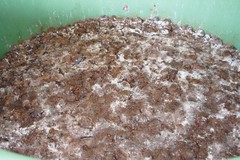 | 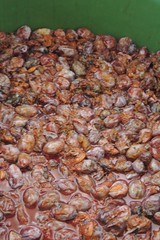 |
Distillation apparatus:
Copper still - a part where fermented komina is cooked. It has a thick bottom and a mixer that prevents burning of rakija.
The dome (kalpak) - goes on the top of still and it's function is to collect vapors created during cooking.
Condensator (tabarka) - attached to the still with a pipe, cools the vapors into liquid.
Fire in the still is traditionally made with wood, but in the recent times new techniques are emerging. This one is gas burner, it is a lot cheaper and effective - regulating the heat is much easier.
The most fun part - tasting :) The first rakija that comes from the condensator is thrown away. Due to presence of pectin in fruit, amount of methanol is inevitable. Throwing it away is essential, since it's extremely toxic! That part of rakija is called "the first born". After that, it is very important to taste it often to see if it weakened. If so, still should be emptied and refilled with new komina. The part that is thrown away is called džibra.
Sometimes the dome starts to leak. It is "repaired" with plain flour dissolved in some water or bran.
The next step is another circle of distillation after which rakija is sealed in oak barrels and should lay in there for at least one month before consumption.
Cheers!!!

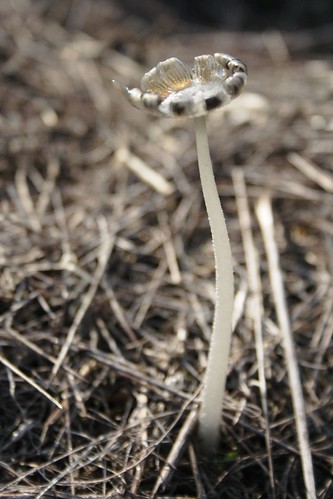
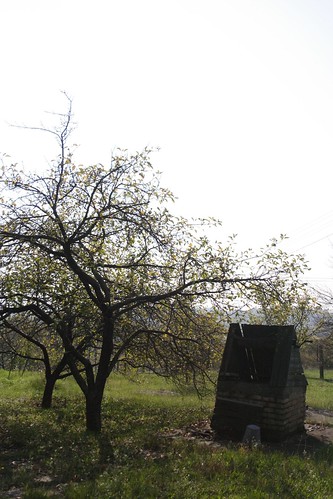
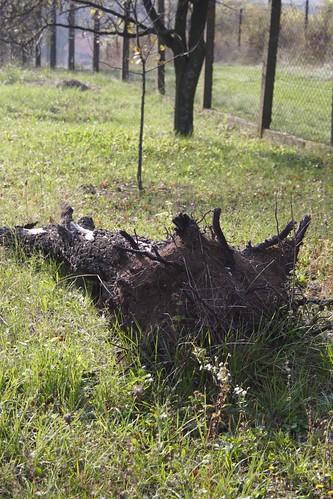
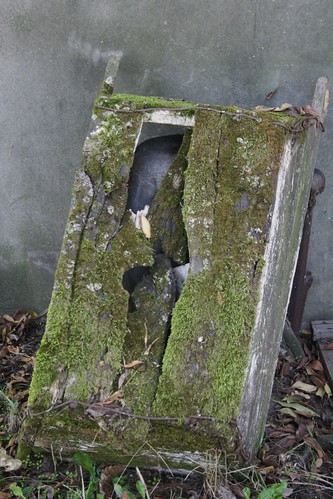
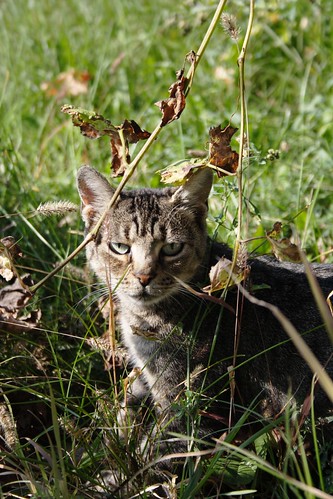
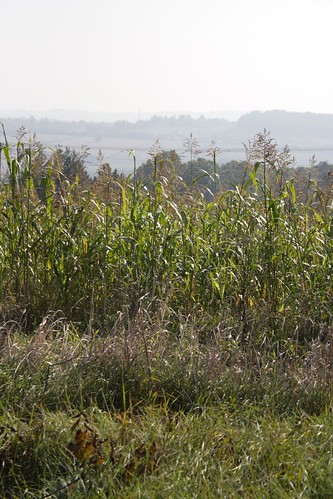
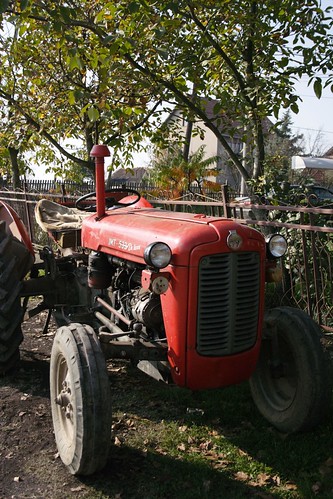
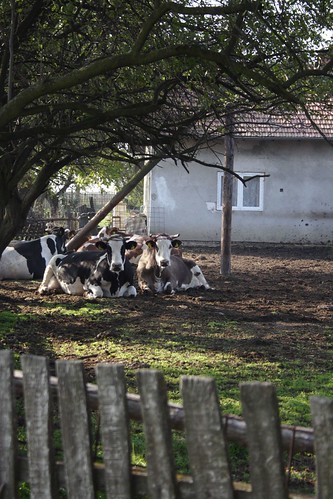
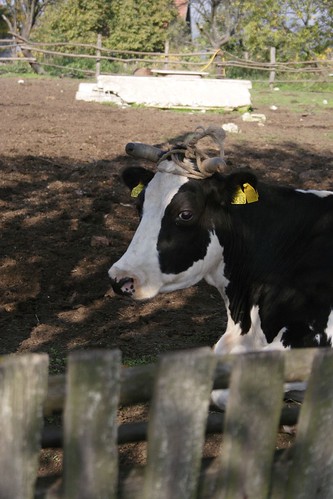
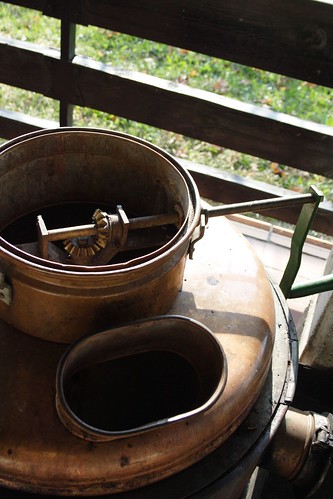
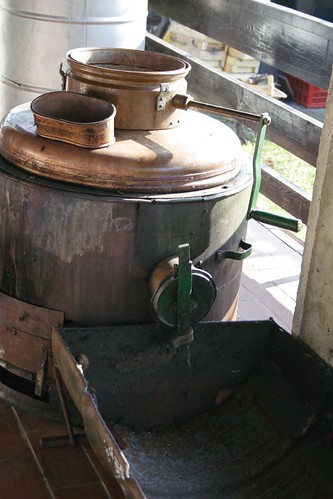
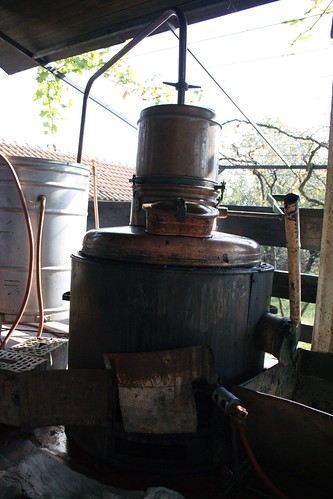
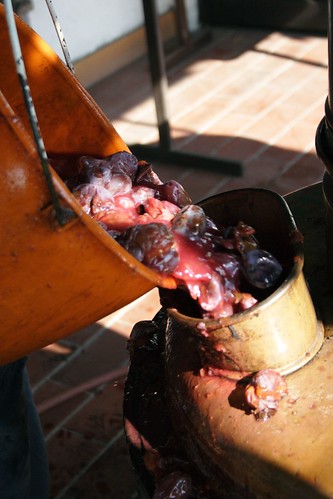
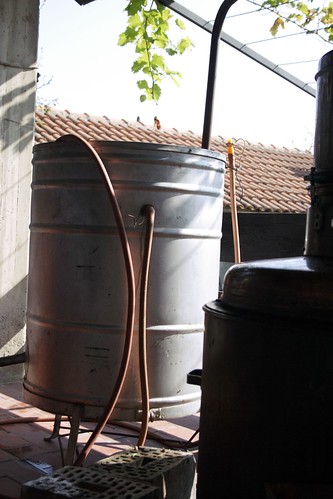

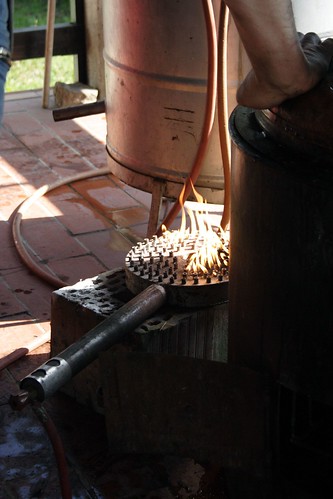
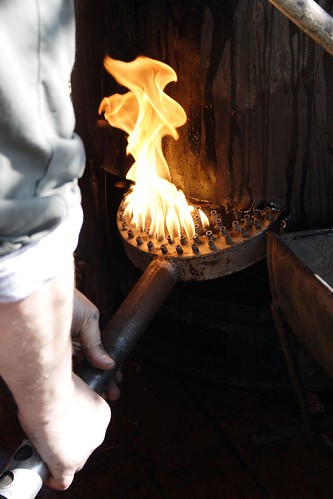
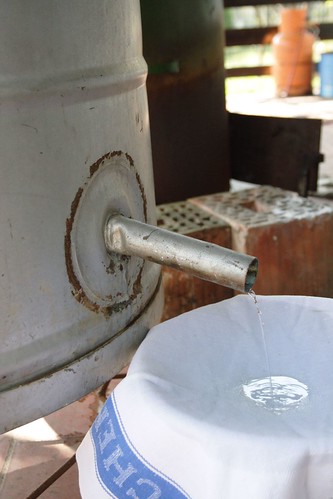
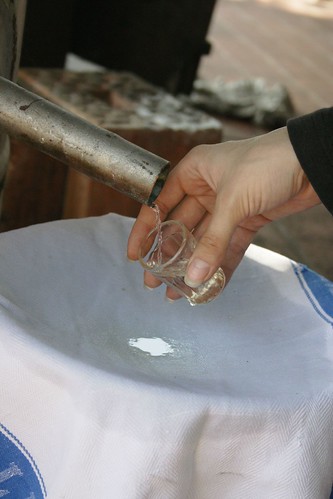
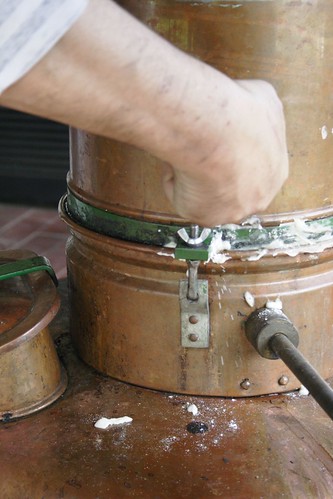
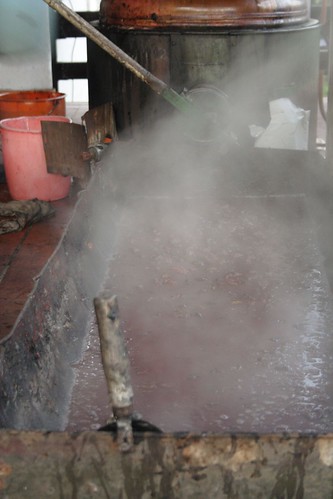
interesting :)
ReplyDeleteThanks for the great pictures and very interesting article!
ReplyDeleteCheers,
Rosa
What a great post! With these wonderful pictures I get so nostalgic!
ReplyDeleteI love also very much rakija made with apricots. My husband's dad makes it that way, just this year there are not enough apricots ;-(
I've had a Czech version - I was already drunk so I can't really remember what it tasted like. But this is really interesting!
ReplyDeleteNajisreniji savet - razmotri neko istrazivacko novinarstvo (uz matematiku). Vredna si i studiozna, imas moj duuuboki naklon!
ReplyDeleteMajo, HVALA!!! :)))
ReplyDeleteHvala lepo! This was my "medicine" when I was little! Worked like a charm when I had a cold! My grandfather also has a bit of it every morning when he wakes up! He's 90!
ReplyDeleteIs this drink like Grappa?? It looks tasty...and your pictures are great.. interesting article...thank you for sharing..
ReplyDeleteandy
www.recipebuddys.com
ja pročitam šta pročitam :) nije da baš ne razumem ništa...
ReplyDeleteslike su ti fenomenalne, svaka čast..
nego, imam ja u selu zevalice, raznih boja... zaista je lep cvet... tako jednostavan, a neodoljiv..
What a wonderful post and fantastic photos! I have to pass this along to my uncle who is a big fan of slivovitz.
ReplyDeleteActually I thought this wonderful plum brandy was called slivovitz. Manistrika is a good brtand available in the US. It is quite smooth. I hate the sweet Czech version!
ReplyDeleteWe first had this drink in Croatia and then in Montenegro about 5 years ago. Now we always celebrate with our Serbian son-in-law for family celebrations like Melania Marko's birthdays with friends and family. Just the adults drink it of course.
mmmmmmmmmmmm...
ReplyDeletebuonissimo!!
I use little little in my prunes jam
http://www.peccatidigolaediamicizia.com/viewtopic.php?f=71&t=3850&start=0&st=0&sk=t&sd=a
lovley!!
baciuss
sjajan clanak...prepisi na wikipediu ovo...muka mi je da gledam da to ispada da je hrvatsko pice i nicije vise! a realno je nase! :) aj ziveli :D
ReplyDeleteFascinating to see how it is made! Here in the US, we call it slivovitz. I've tried it here and in Croatia, but it is NOT something I drink often. My grandfather, on the other hand, drank one glass of it every night and lived to the age of 91.
ReplyDeleteBlather From Brooklyn
Love it! My mom's father claimed he was given slivovice right after he was born; and he gave it to my dad to "test" him the first time they met. ;-)
ReplyDeletei had a chance to wittness rakia being cooked approx 10 yrs ago in vukovar. first during the summer, my serbian landlord made me curious as to why they were throwing all fallen plums to a big container (that smelled a bit...) when october came the landlord asked me over to his neighbours backyard (village brewery, i later found out) to watch how to make rakija. when i left vukovar, the landlord gave me a bottle of his rakia, i still have some of it left, i save it for very special occasions. they were such nice people and your article brought back wonderfull memories, thank you.
ReplyDeleteVery accurate description of the making process. History, although accurate as it is, is not complete though. Rakija or Sljivovica is not only a Serbian drink. It has been made and used for the same amount of time among all the nations of the former Yugoslavia - Serbia, Croatia, Macedonia, Bosnia, as well as other eastern and western european countries such as Romania, Bulgaria, Italy and Greece. It is more of a regional spirit with local variations.
ReplyDeleteNo matter where it comes from, it is a very great experience to watch someone taste it for the first time.
Thanks for a great article!
Excellent post! I meant to write an article on this topic, but I lacked time this autumn... Hopefully I'll do it next year :) But, until then, everyone should definitely enjoy your article, it's so easy to read, yet very informative.
ReplyDeleteCheers! ;)
Imam veliki voćnjak ispod kuće,na selu, od kud mi je tata, uglavnom sa stablima šljiva..kao mala još sam ih gazila nogicama u seoskim kolima ,vukli smo ih konjima i kolima uz brdo do kuće..Tata je sam napravio kotao za peći rakiju , čak i još nekim ljudima u selu, bio je "mašinski" inžinjer u nekadašnjoj "Jugoturbini"..tako da mi je sve ovo jako,jako blisko..onda bi ju prepicao..zvalo se to nekako "plavica"...Na isti način se preko krpe to cijedilo u lonac i prelijevalo u veće kanistre..Imali smo i isti ovakav traktor...Davno je to bilo prije 20-tak godina..slikama si me vratila u prošlost, pozdrav!
ReplyDeleteDo you know where I can find a recipe? I'm toying with the idea of trying to make a batch for myself.
ReplyDelete